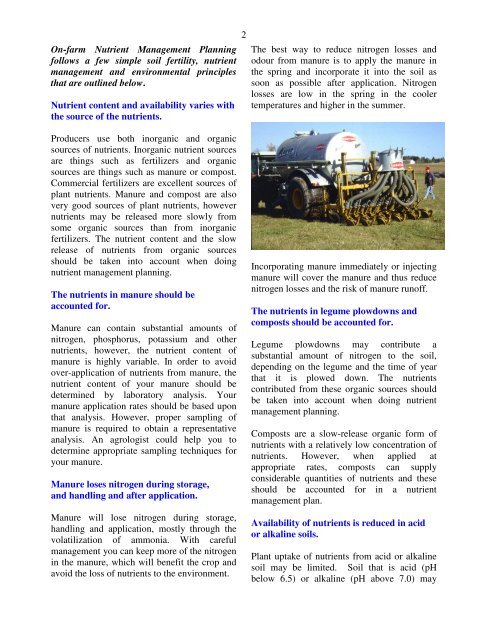Create successful ePaper yourself
Turn your PDF publications into a flip-book with our unique Google optimized e-Paper software.
On-farm <strong>Nutrient</strong> <strong>Management</strong> <strong>Planning</strong><br />
follows a few simple soil fertility, nutrient<br />
management and environmental principles<br />
that are outlined below.<br />
<strong>Nutrient</strong> content and availability varies with<br />
the source of the nutrients.<br />
2<br />
The best way to reduce nitrogen losses and<br />
odour from manure is to apply the manure in<br />
the spring and incorporate it into the soil as<br />
soon as possible after application. Nitrogen<br />
losses are low in the spring in the cooler<br />
temperatures and higher in the summer.<br />
Producers use both inorganic and organic<br />
sources of nutrients. Inorganic nutrient sources<br />
are things such as fertilizers and organic<br />
sources are things such as manure or compost.<br />
Commercial fertilizers are excellent sources of<br />
plant nutrients. Manure and compost are also<br />
very good sources of plant nutrients, however<br />
nutrients may be released more slowly from<br />
some organic sources than from inorganic<br />
fertilizers. The nutrient content and the slow<br />
release of nutrients from organic sources<br />
should be taken into account when doing<br />
nutrient management planning.<br />
The nutrients in manure should be<br />
accounted for.<br />
Manure can contain substantial amounts of<br />
nitrogen, phosphorus, potassium and other<br />
nutrients, however, the nutrient content of<br />
manure is highly variable. In order to avoid<br />
over-application of nutrients from manure, the<br />
nutrient content of your manure should be<br />
determined by laboratory analysis. Your<br />
manure application rates should be based upon<br />
that analysis. However, proper sampling of<br />
manure is required to obtain a representative<br />
analysis. An agrologist could help you to<br />
determine appropriate sampling techniques for<br />
your manure.<br />
Manure loses nitrogen during storage,<br />
and handling and after application.<br />
Manure will lose nitrogen during storage,<br />
handling and application, mostly through the<br />
volatilization of ammonia. With careful<br />
management you can keep more of the nitrogen<br />
in the manure, which will benefit the crop and<br />
avoid the loss of nutrients to the environment.<br />
Incorporating manure immediately or injecting<br />
manure will cover the manure and thus reduce<br />
nitrogen losses and the risk of manure runoff.<br />
The nutrients in legume plowdowns and<br />
composts should be accounted for.<br />
Legume plowdowns may contribute a<br />
substantial amount of nitrogen to the soil,<br />
depending on the legume and the time of year<br />
that it is plowed down. The nutrients<br />
contributed from these organic sources should<br />
be taken into account when doing nutrient<br />
management planning.<br />
Composts are a slow-release organic form of<br />
nutrients with a relatively low concentration of<br />
nutrients. However, when applied at<br />
appropriate rates, composts can supply<br />
considerable quantities of nutrients and these<br />
should be accounted for in a nutrient<br />
management plan.<br />
Availability of nutrients is reduced in acid<br />
or alkaline soils.<br />
Plant uptake of nutrients from acid or alkaline<br />
soil may be limited. Soil that is acid (pH<br />
below 6.5) or alkaline (pH above 7.0) may
















